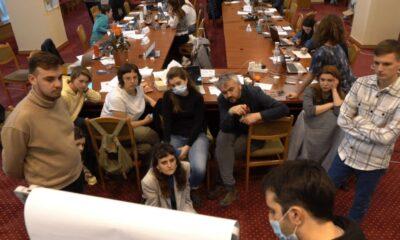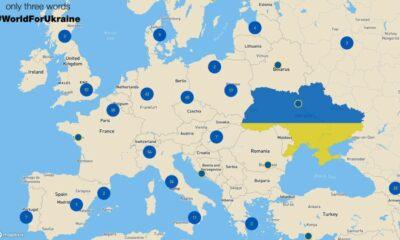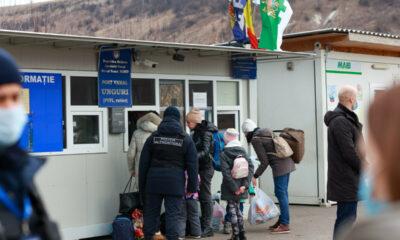Economy
Ashgabat and New Delhi strengthen economic cooperation
Reading Time: 4 minutesFor more than 15 years, the Trans-Afghanistan Pipeline (TAPI) project, which proposes to deliver gas from Turkmenistan to Pakistan and India via Afghanistan, has remained an elusive scheme.
by Roman Muzalevsky
For more than 15 years, the Trans-Afghanistan Pipeline (TAPI) project, which proposes to deliver gas from Turkmenistan to Pakistan and India via Afghanistan, has remained an elusive scheme. Backed by the West and the Asian Development Bank (ADB), it is a subject of intense debate centering on security conditions in the Afghanistan-Pakistan region and rivalries between New Delhi and Islamabad (www.utro.ru, June 2). Yet, the recently intensified contacts among parties to the proposal (particularly between India and Turkmenistan) indicate growing prospects for the TAPI. If the pipeline becomes operational, it will serve as an interconnector linking Central and South Asia, laying the foundation for a multi-sided strategic partnership between India and Turkmenistan – two states with differing political systems that are also eager to promote diversification in their foreign relations, especially in the energy field. The visit by Turkmen President, Gurbanguly Berdimuhamedov, on May 26 to India represented another step in this direction.
Meeting with Indian Prime Minister, Manmohan Singh, and President, Pratibha Devisingh Patil, Berdimuhamedov reaffirmed Ashgabat’s interest in the TAPI pipeline. He emphasized that Turkmenistan views India as its strategic energy partner. Singh, in turn, expressed keen interest in the proposal, stressing it would bring immense value to all participants (www.ferghana.ru, May 27). Berdimuhamedov’s visit comes after the April conference in Ashgabat that convened the interested parties for the first time in three years to discuss the stalled project (Dawn, March 15).
If launched, the TAPI has potential to more tightly connect Central and South Asia –the regions once estranged by decades of Russian-British rivalries and the Cold War. The project will also lead to opening new or expanding existing trade, electricity and transit networks across Eurasia, enhancing the competiveness of Central and South Asia in the global economy. It will further allow Turkmenistan and India to boost and diversify their trade and energy relations with countries in South Asia, CIS and Europe (www.turkmenistan.gov.tm, May 26).
Currently, Indian-Turkmen relations underperform, despite their tremendous potential. There is only one joint venture, Turkmenderman-Ajanta Pharma Ltd, which has operated after the disbursement by India of $15 million in loans to Turkmenistan. From April 2007 to March 2008 the trade turnover between the two countries reached a mere $45 million, with imports by Turkmenistan constituting $36.39 million. The signing of agreements on trade, energy, and technology during Berdimuhamedov’s visit and plans to launch a related inter-governmental commission demonstrates that both parties intend to boost their relations, with the TAPI potentially serving as the engine in the bilateral relationship (www.ferghana.ru, May 27).
Turkmenistan is interested in promoting trade and investment relations with India, as the latter economy has grown rapidly, even in the aftermath of the global financial crisis. Berdimuhamedov, for instance, called on India to invest in Turkmenistan’s chemical, mining, textile, pharmaceutical, and telecommunications industry. Ashgabat now aims to diversify its economy while prioritizing the energy industry and exports as the driving force behind the diversification process (www.turkmenistan.gov.tm, May 24; www.ferghana.ru, May 27). This process has gained momentum after gas-related disputes with Russia in the wake of the global financial crisis that led to massive profit losses for Turkmenistan and reduced Russian imports of Turkmen gas (EDM, May 12).
India, in turn, seeks access to Central Asian energy reserves and the expanding regional presence of China. The recently constructed pipeline carrying gas from Turkmenistan to China via Uzbekistan and Kazakhstan clearly demonstrates that India is a late-comer in Central Asia. To compete globally and regionally, India needs to rapidly reconnect with Central Asia. Reinvigorating the work on the TAPI, which will provide India with 60 percent of the 33 billion cubic meters (bcm) of gas annually, is therefore essential for New Delhi, given the lack of prospects to import gas from Iran (Dawn, March 15). Turkmenistan’s Davletobad deposits, which contain 4.5 to 16 thousand cubic meters (tcm) of gas, can easily supply India with the necessary volumes of gas. New Delhi requires up to 110 bcm of gas annually to meet its needs, while Ashgabat currently plans to export to a diverse group of countries up to 125 bcm of gas per year by 2015 (www.turkmenistan.ru, May 24; www.chrono-tm.org, May 26; www.integrum.ru, May 20, 2005; www.energyland.info, May 10).
Difficult security conditions in Afghanistan and unresolved issues between India and Pakistan may serve to encourage the launch of the TAPI rather than cause its failure. Moreover, providing its parties with diversified energy imports, the project would assist with the reconstruction of Afghanistan by providing twelve thousand jobs to the Afghans and $400 million in annual transit fees to the country (www.islamnews.ru, April 3). The planned withdrawal of coalition forces only reinforces this imperative as the operation of the pipeline will ensure a steady stream of financial flows, with local and regional actors gradually developing a lasting stake in the emerging economic links. The TAPI will also contribute to a more competitive economic and political environment in Central Asia, providing Ashgabat with more room to maneuver vis-à-vis Russia, the West, China, India and Iran –the players that either have, or plan, a significant presence in Turkmenistan’s energy sector.
Pakistan, expected to increase its annual gas consumption to 44.5 bcm this year, will also benefit from the TAPI through diversified and expanded energy and trade relations with regional actors (www.integrum.ru, May 20, 2005). India, Pakistan and Afghanistan have already signed a framework agreement to purchase gas from Turkmenistan. Western support for the project makes the TAPI a viable undertaking, particularly considering international attempts to isolate Iran –another potential but less likely source of gas for India– from regional initiatives (www.utro.ru, June 2; www.chrono-tm.org, May 26; Dawn, March 15).
India has actively supported Turkmenistan’s neutrality, just as Ashgabat has backed New Delhi’s candidacy for a rotating seat on the UN Security Council for 2011-2012 (www.turkmenistan.gov.tm, May 26). Both states clearly do not confuse traditions of neutrality, relevant for both nations, with the need to diversify their foreign relations. India’s unprecedented economic growth and Turkmenistan’s search for diversification naturally encourage them to revive the TAPI project that will only further bind Central and South Asia with markets across Eurasia, while enhancing the prospects of a multi-faceted strategic partnership between New Delhi and Ashgabat in the process.
Economy
Moldova will receive a disbursement of 36 million euros as part of the the Economic Recovery Plan
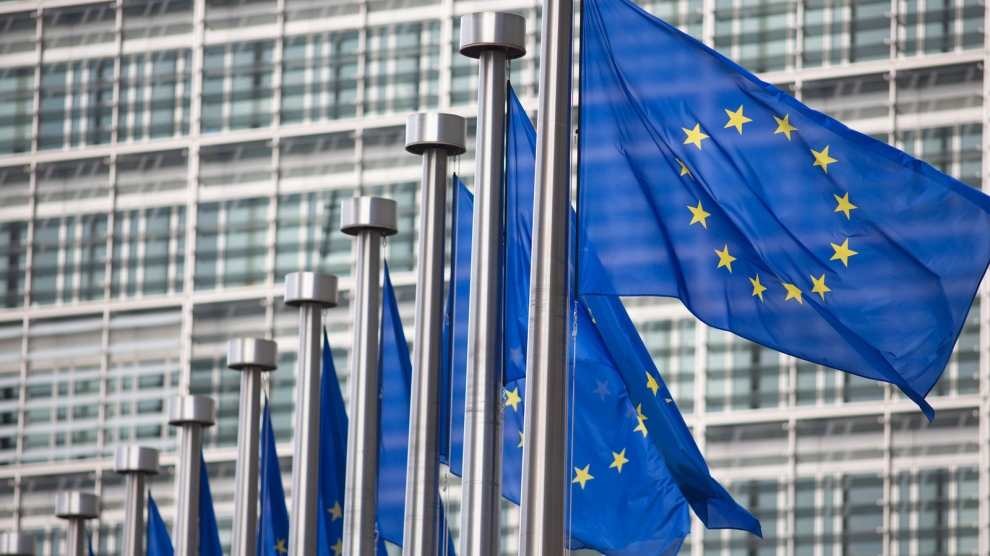
This week, the European Commission approved the disbursement of 36 million euros in grant money for the Republic of Moldova. The announcement was made by Deputy Director-General for Neighbourhood Policy and Enlargement Negotiations at the European Commission, Katarina Mathernova, who paid an official visit to the Republic of Moldova between September 13-15, together with Managing Director for Russia, Eastern Partnership, Central Asia, Regional cooperation and OSCE, at the European External Action Service, Michael Siebert.
The EU officials had meetings with President Maia Sandu, Minister of Foreign Affairs and European Integration, Nicu Popescu, Speaker of Parliament, Igor Grosu, Prime Minister of the country, Natalia Gavrilita, as well as key representatives of Government, international financial institutions and the civil society, according to a press release issued by the Delegation of the European Union to the Republic of Moldova.
Beside such topics as the EU-Moldova relations and prospects, the priorities of the reform agenda of the new Moldovan Government, preparations for the Eastern Partnership Summit at the end of the year and the Transnistrian conflict settlement, the officials also discussed the EU assistance in support of reforms and the Economic Recovery Plan for Moldova, which was announced in June with a total EU support of 600 million euros over the next 3 years.
“The first measures under the Economic Recovery Plan will shortly materialize, with the expected disbursement of 36 million euros in grant money under budget support programmes to support the authorities’ efforts to fight against the consequences of the pandemic. Moldova can count on EU’s assistance on its path to reforms and to recovery, bringing tangible results to citizens,” Katarina Mathernova stated.
The plan is based on assistance provided by the European Union through various bilateral and regional instruments, aiming to mobilize the funds in the form of grants, loans, guarantees and macro-financial assistance.
“The Economic Recovery Plan for the Republic of Moldova involves much more, not just this financial support provided immediately. It must help digital transformation, strengthen infrastructure, energy efficiency, education and support small and medium-sized enterprises,” the EU official also said.
As Prime Minister Natalia Gavrilita informed, “The Economic Recovery Plan and the 5 flagship initiatives for Moldova in the Eastern Partnership will directly contribute to the reform and consolidation of institutions, stimulate long-term socio-economic development, bring direct benefits to citizens, and unleash new economic opportunities through promoting the green agenda and digitization. Small and medium-sized enterprises (SMEs) have been hit hard by the crisis. Promoting and diversifying access to finance and reducing collateral requirements will be essential in supporting economic operators. We are grateful to the EU partners who will launch two programs to support 50 000 independent Moldovan SMEs to adapt to the new conditions.”
President of the Republic of Moldova, Maia Sandu, welcomed the decision of the European Union to disburse about 745 million lei in grant money, as the official page of the President’s Office announced. “EU support comes after a long period of freezing of European assistance, caused by former governments. We managed to relaunch the political dialogue with the European Union and resume financial assistance. The Republic of Moldova is gradually regaining the trust of its strategic partners. This European support is also a signal of encouragement for the new Government team in its commitment to clean up the institutions, fight corruption and launch development programs in the country,” said Maia Sandu.
Photo: unknown
Economy
Romania and Moldova signed a partnership memorandum pledging to cooperate in promoting their wines

The Chamber of Commerce and Industry of Romania (CCIR) and the National Office for Vine and Wine (NOVW) of the Republic of Moldova signed, last week, a memorandum of cooperation on organizing joint promotional activities in the markets of common interest, as the CCIR announced.
China, Japan or the USA are just some of the markets targeted by the Romanian and Moldovan institutions. The memorandum also involves advertising activities for wines from common indigenous varieties, promoting the oeno-tourist region, developing a tourist route in the two states, exchange of experience, study visits, and mutual support in identifying new export opportunities. “We are very confident that this collaboration between our organizations will lead to sustainable economic growth and a higher degree of well-being among Moldovans and Romanians,” claimed Deputy Secretary-General of CCIR, Bogdan Visan.
On the other hand, Director of the NOVW, Cristina Frolov, declared that no open competition with Romania is aimed at the governmental level of the Republic of Moldova. “This request for collaboration is a consequence of the partnership principle. Romania imports 10-12% of the wine it consumes, and we want to take more from this import quota. Every year, the Romanian market grows by approximately 2.8%, as it happened in 2020, and we are interested in taking a maximum share of this percentage of imported wines without entering into direct competition with the Romanian producer,” the Moldovan official said. She also mentioned that Moldova aims at increasing the market share of wine production by at least 50% compared to 2020, and the number of producers present on the Romanian market – by at least 40%.
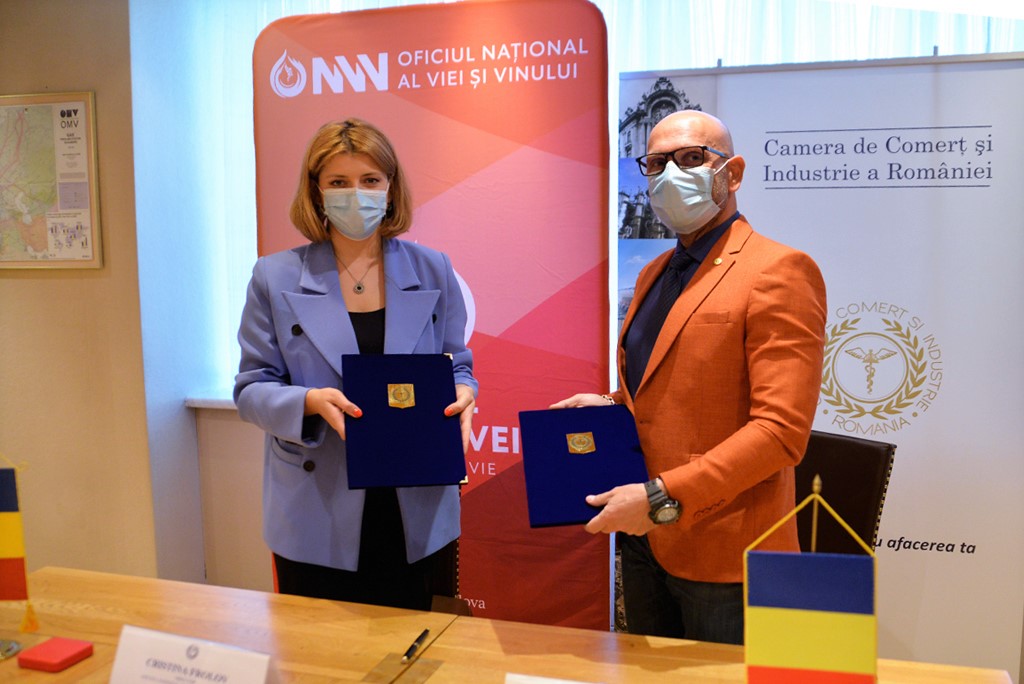
Source: ccir.ro
**
According to the data of the Romanian National Trade Register Office, the total value of Romania-Moldova trade was 1.7 billion euros at the end of last year and over 805 million euros at the end of May 2021. In July 2021, there were 6 522 companies from the Republic of Moldova in Romania, with a total capital value of 45.9 million euros.
The data of Moldova’s National Office of Vine and Wine showed that, in the first 7 months of 2021, the total quantity of bottled wine was about 27 million litres (registering an increase of 10% as compared to the same period last year), with a value of more than one billion lei, which is 32% more than the same period last year. Moldovan wines were awarded 956 medals at 32 international competitions in 2020.
Photo: ccir.ro
Economy
Moldova’s hope to be a top walnut exporter and its main difficulties
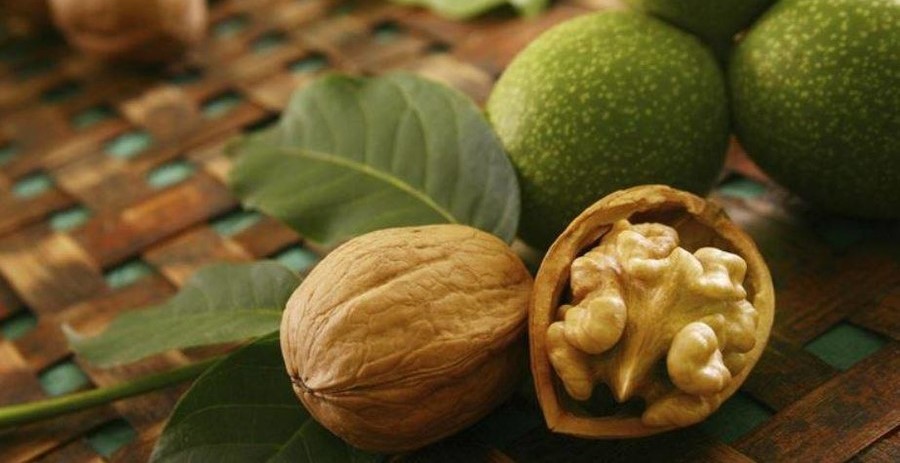
The Republic of Moldova has perfect weather conditions for growing walnut trees, that creating a great potential of walnut production and trade, especially on international markets, where the demand is way higher than the product’s supply. National and international experts believe that the country’s walnut production industry is on the verge of important transformations, which could lead to increased yields, quality and competitiveness worldwide.
According to authorities, Moldova exports 34-35 thousand tons of walnuts in shell, which is about 7% of the total export of fruit and 5% of the total export of horticultural products. The export value is assessed as being $120 million, that being 57-60% of the total fruit export value and about 50% of horticultural export value. Most of walnut crops are exported to the EU countries, such as France, Germany, the Netherlands, Romania and Austria. The country’s exports were among the world’s top 10 when it comes to the highest dollar value of the product during 2020.
Viorel Gherciu, Minister of Agriculture and Food Industry, pointed out that the production in the domestic walnut industry has increased by 55% in the last five years, which ranks Moldova among the main producers in the world.
“The biggest opportunity for this industry is that we are in the geographical proximity of the largest walnut import area in the world, which is the European Union, with almost 40% of total imports in the world. We are on the EU border, with privileged relations, with an Association Agreement. We already enjoy a good relationship in working with European importers, they trust our processors. A very close collaboration has been created and this is, in fact, the guarantee for those who invest in the area,” claimed the president of the Walnut Producers Association, Oleg Tirsina.
The data provided by the National Bureau of Statistics show that there are 34.7 thousand hectares of walnut plantations in the country. 20.90 hectares are represented by orchards. 75% of planted orchards are formed of old varieties trees. 30-35% of the exported production comes from orchards, the rest comes from individual farmers and plantations along the roads. This means that the quality of walnut production is not at its maximum potential. Developing commercial plantations through orchards modernization and extension of walnut varieties would provide double yield and better quality, experts say.
Governmental support in the form of subsidizing solutions, foreign investments and credit options are indispensable for the industry development. One of the financing options is the credit line of the European Investment Bank Project. Since 2016, 15 producers and processors of nuts, almonds and hazelnuts have benefited from these loans with the total amount of investments worth 8.7 million euros. A further extension of the project would provide another 60 million euros for the modernization of the horticultural sector in general and for harvesting organic walnuts in particular.
Photo: heymoldova.com


